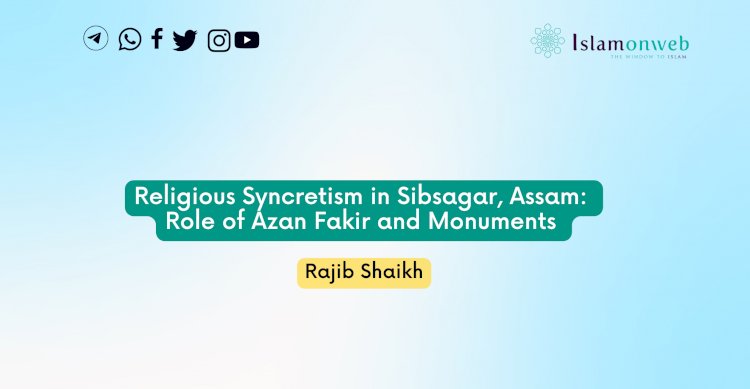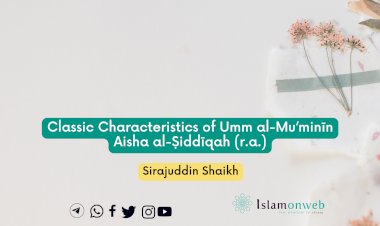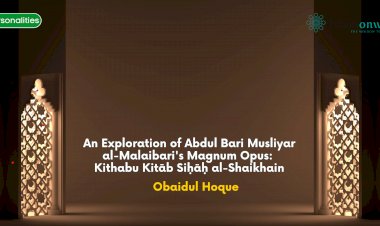Religious Syncretism in Sibsagar, Assam: Role of Azan Fakir and Monuments
Religious syncretism is one of the most interesting events in a country like India where various types of ethnic groups with their own culture, tradition, religion, language and different origins live together as a nation of 'unity in diversity'. When we talk about cultural diversities, the northeastern part of India, commonly known as ‘seven sisters and one brother’, possesses a distinctive status for its amalgamation of culture, tradition and historic expedition of Hindu saints and Muslim Sufis. The state of Assam has often been termed the land of Azan Fakir and Srimanta Sankerdeva, the two religious leaders of medieval Assam who changed its socio-cultural landscape and promoted syncretic cult in this land as they had established the Bhakti Movement and Sufism respectively.
The city of Sibsagar occupies an essential position in the history of Assam as the major settlement of the Ahom Kingdom, the advent of religious leaders particularly Azan Fakir was taken place. Moreover, being a homeland of various ethnic groups including Mishing, Naga, Deori, Manipuri and Garo and their arts, folklore, costumes, dances, festivals languages and architectural sites of different religions collectively exhibit the rich tradition of Assam and promote the cross-cultural relationships in the district.
Therefore, this article looks into the syncretic cult of Sibsagar district and contribution of both Hindu-Muslim rulers and Sufis in promoting religious harmony in the state.
Azan Fakir as a protagonist of cultural assimilation: Zikr and Jari
Shah Miran, commonly known as Azan Fakir, was a 17th-century Sufi-saint, scholar, poet and socio-religious reformer of Assam who came here approximately 200 years after the birth of Srimanta Sankerdeva. He was a Fakir because he travelled all the way from Baghdad to Assam. When he arrived in the Ahom kingdom, he was dismayed to see the religious practices of Muslims that were not different from Ahom, who were Hindus. He felt that he had to guide the Muslim community towards their faith, and realising this he established a Mosque in Sonpura near Sibsagar and owned the title of Azan Fakir for practising Azan in Mosque.
Without any doubt, Azan Fakir was a forerunner of Assamese arts, culture and literature. He was a sign of religious harmony who stands most prominently as a promoter of the syncretic culture of Assam. Hazrat Azan Pir Saheb was an untiring champion of humanity. He is never known to write against Hinduism and thought to discriminate on the basis of religion because he was a secularist who struggled against communalism, nationalism and superstitions. Therefore, his concern about religious harmony can be understood through some important details of this spiritual leader.
Firstly, he married an Ahom woman and learnt the local language. Secondly, he imbibed the teaching and music of Vaishnavite saint Sankerdeva and wrote two genres of devotional song, Zikr and Jari which, resembles his Borgeets and contribute to promoting a syncretic culture of this district[1].
Zikr and Jari[2] are two devotional songs composed by him. Zikr is an Arabic word; it means to remember Allah, while Jari is to chant tragic events of Karbala, which not only promotes Assamese literature but also plays a vital role in establishing a pluralistic society. Although he was Arabian, but he still learnt the Assamese language. After him, numerous scholars such as Chandkha, Sheikh Fariduddin, Munia Dewan, Bandan Fakir, Maznudil Fakir, Syed Murtaza and Gulam Hussain are found as writers of Zikr and Jari. However, the style and the way of writing strikingly resemble the Borgeets of Sankerdeva, and this is the reason that both Hindu-Muslims widely accept these songs. Azan Fakir composed these songs not only on a religious basis but also elaborated to establish pluralistic societies and to ease the process of religious syncretism. In one of his poem, he described that:
Mor manat bhin par nai,
oi Allah Mar manat bhin par nai
Hindu ki mussalman ekei allar forman
Mar manat eketi bhab[3].
O, Allah, There is no difference in my mind. Both the Hindu and Muslim are the creation of the one Allah. And in my mind the same thought.
People were gathering to chant Zikr and Jari, and after it, he used to treat people with Firni, made of rice, milk, and nuts. When the wave of his followers began to flow, Rupai Dadhora, a Muslim official of Ahom, complained his ruler that Azan Fakir’s teaching was against Islamic faiths and corrupting the people. He was also accused of being a Mughal spy. So the King ordered him to pluck out his eyes. After plucking out his eyes, Dadhora narrated that as soon as he dropped his eyes, the river began flowing opposite direction![4] So, one can understand how spiritual he was. On hearing this miracle, King regretted and, in his remembrance, built a shrine in Shah Miran’s name, which has since been visited by both Hindu-Muslim communities, and every year Urus, festivals are held here every year to remember this unforgettable leader.
Coming back to the present situation, when there is continuous growth of intolerance and rising incidents of hate crimes among communities mainly Hindu and Muslims and deliberate spread of hate and abhorrence by various sections of society, by applying political ideology. Recurring incidents of mob lynching, hate crimes, love jihad terminology, hate against minorities, anti-migrant sentiments and many more elements inciting violence, convince us of the vital importance of Azan Fakir’s interfaith ideology to enable peaceful, tolerant and global citizenship. Time demands rethinking Azan Fakir’s teaching of religious harmony, which provides a refreshing site to begin the process of peace-building, amity and tolerance.
However, without any doubt, Azan Fakir influenced Assamese society through his teachings and literary works and did a commendable job advocating Hindu-Muslim unity, amity and tolerance.
Architectural sites: the symbol of pluralism
Sibsagar district is bestrewed with architectural sites of the Ahom Kingdom. The numerous mammoth man-made palaces, temples and Dargah can still be found there. Such historical monuments can be described as amalgamating various cultures, traditions and religious influences.
Sibsagar Tank is one of the remarkable constructions of Ahom rulers, which locates in the mid of the town. This vast man-made tank was built by Queen Ambika in 1734 AD. It covers approximately 257 acres of area, and the depth of water is 27 feet. Sibsagar Tank is surrounded by a number of temples known as Siva Dol, Vishnu Dol and Devi Dol, dedicated to Lord Shiva, Lord Vishnu and goddess Durgah, respectively[5].
Rang Ghar (the house of entertainment) was established in 1747 AD which is now considered as the oldest surviving amphitheatres in Asia. Here Ahom rulers used to watch baffallo fights, cockfights and other sports, dance forms, particularly during the Rongali Bihu festival. It was built by Swargadeo Rudra Singha with bamboo and woods and later it was rebuild by King Sunenpha in 1744-1750[6].
Talatal Ghar is another architectural site of Ahom ruler, established in Sibsagar. It was initiated by Swargadeo Rudra Singha in 1698 AD. Talatal Ghar has three floors below the ground and two secret tunnels used as exit routes for Ahom family in case of any distress. It is situated near Rang Ghar.
Kareng Ghar is also one of the strongest buildings by Ahom rulers. It is known as Gargaon palace, which stands as capital of kingdom for four centuries before it shifted to Sibsagar. It is believed that there is a secret underground tunnel from Kareng to Talatal Ghar’ in Sibsagar across river Dikhow[7].
Azan Fakir Dargah situates around 22 KM from Sibsagar town at Sonpura. Azan Pir Dargah was dedicated to a great reformer and Sufi saint Shah Miran. It is a divine place where everyone, irrespective of caste and religion can feel a sense of inner peace.
However, Sibsagar is a majestic city as she witnessed some of the most remarkable transition in the cultural history of Assam. These all historical monuments exhibit the rich traditions of Assam. Such illustrious past and intangible splendors make Sibsagar the heritage capital of Assam. Moreover, these palaces and religious sites are visited by all sections of people, which not only promote unity but also promote religious syncretism in the district. There have been many instances where Hindu religious sites have been taken care of by Muslims for years, and Muslim sites have had been under the care of Hindus. Therefore, these interconnections and interfaith understandings promote the syncretic culture of Sibsagar, and it sculpts a solid rock of brotherhood.
Assam as a state of diverse cultures it has witnessed multiple communal conflicts on religious line from pre to post-independence. The pending border disputes, Anti-immigrant sentiments, tribal conflicts on the basis of language, love jihad terminology push religions toward tensions and more specifically, these became a massive trial for minority communities to live under the current wave of aggressive nationalism and Hindutva ideologies which are distorting the secular identity of the Assam and as well as the entire nation.
Therefore, it will take essential duty for all religious leaders, especially those who live and work within a multi-cultural, multi-lingual and multi-religious society, must re-read the pluralistic culture of Sibsagar and the philosophy of Azan Fakir as well as of Sankerdeva to enable cultural and social pluralism.
Notes and References:
❖ Rahul, Sibsagar-the heritage capital of Assam, the kite manja, 17-2020
❖ Shaheen Ahmed, The author is a PhD research scholar at the School of Arts and Aesthetics, Jawaharlal Nehru University, the wire, The Fading Memory of Assam's Syncretic History, 10Apr 2016)
❖ Dr. Md. Shah Noorur Rahman, Assistant Professor, Dept. of History, NEHU, Shillong, Religious and Cultural Syncretism in Medieval Bengal, The NEHU Journal, Vol XVI, No. 1, January - June 2018, pp. 53-77
❖ Arman Baumik , Ekasarana Dharma of the Ahoms: Rongali Bihu of Sibsagar, Shapedia, 27 November 2018
❖ Sivasagar: A Walk through 600 years, an edited version of this article on Sivasagar was published in the July-August issue of Discover India’s NE Magazine, 8-2017)
❖ the writer, a freelance journalist, has been associated with several social movements Syncretic culture that deserves protection, Bharat Dogra | December 14, 2015)
❖ Sibsagar, the former capital of the mighty ahoms
❖ Azan Faqir of Assam: A little-known disciple of Hazrat Khwaja Nizamuddin Auliya from Baghdad
Endnotes:
[1] Mahasweta Dey: MA history in cotton university, Azan fakir steering Assam’s muslims back to the faith, June 8th, 2021
[2] Abul Hussain: Research Scholar Department of Folklore Research Gauhati University, Reflection of Assamese culture in Ajan Fakir’s Jikir, Journal of Emerging Technologies and Innovative Research (JETIR) 2019.
[3] Sanjoy Paul: Mor manat bhin par nai: The jikirs and jaris of Ajan Fakir
[4] Mahasweta Dey: MA history in cotton university, Azan fakir steering Assam’s muslims back to the faith, June 8th, 2021
[5] Rahul: a traveler, Sibsagar the heritage capital of Assam, 7 sisters, 17 June, 2020
[6] Sivasagar: A Walk through 600 years, an edited version of this article on Sivasagar was published in the July-August issue of Discover India’s NE Magazine, 8-2017)
[7] Rahul: a traveler, Sibsagar the heritage capital of Assam, 7 sisters, 17 June, 2020
Disclaimer
The views expressed in this article are the author’s own and do not necessarily mirror Islamonweb’s editorial stance.
























Leave A Comment